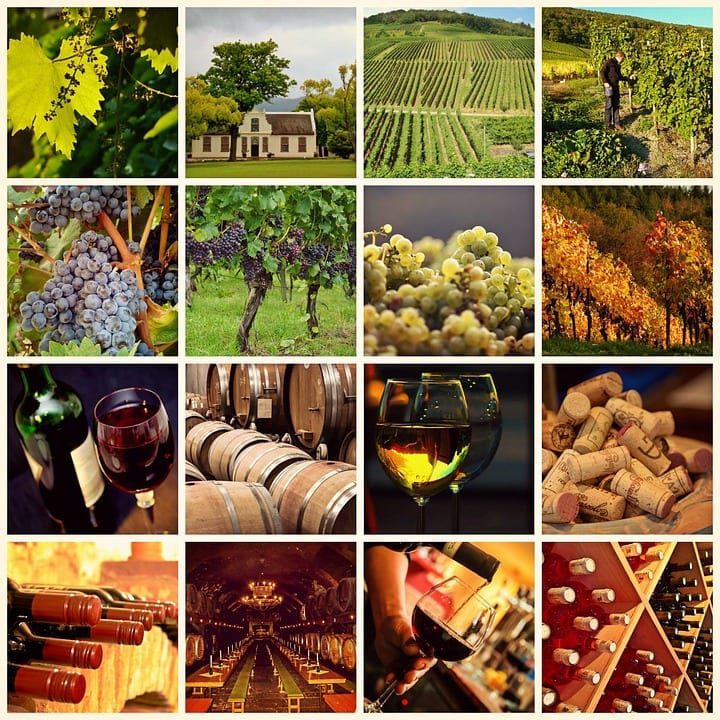You may have noticed that white wine isn’t white at all; rather, it’s various shades of yellow. It’s often made from white grape juice but can also be made from the juice of skinned red grapes. With the exception of some sparkling varieties, there are very few white wines made from red grape juice.
White wine is usually served chilled, but shouldn’t be ice cold. If you are used to drinking white wine in this manner, allow it to warm a bit–you’ll probably find even more to like about it.
Popular white-wine types include chardonnay, sauvignon blanc, riesling, pinot grigio and soave. There are 50 major white grapes grown in the world today, 24 in California alone. The three most important grapes are as follows: Riesling grown best in Germany, Alsace, France and New York State; Sauvignon Blanc grown best in Loire Valley, France; Bordeaux, France, New Zealand and California (Fumé Blanc); Chardonnay grown best in Burgundy, France; California; Australia; and Champagne, France.
European wines will usually be identified by their appellation; elsewhere wines will be identified by varietal.
Chablis
From the most northern vineyards in Burgundy comes Chablis, a steely, dry, and often age-worthy white wine. Chablis vineyards are ranked (in descending order of quality) as Chablis Grand Cru, Chablis Premier Cru or 1er Cru, Chablis, and Petit Chablis. Chablis is made, like all fine white wine in Burgundy, from Chardonnay. In the New World, the name Chablis has been burrowed as a generic name and is used to describe dry white jug or box wine that bears no true resemblance (other than color) to Chablis.
Chardonnay
Chardonnay is to white wine what Cabernet is to reds. It is used to produce France’s magnificent white Burgundies and is the main grape in Champagne. But Chardonnay also has a populist bent – in the last decade or so, it has become the world’s most often-purchased dry white wine. Indeed, because of its great adaptability, it grows in nearly every wine-producing area of the world; some California Chardonnays are stellar examples of the genre. When Chardonnay wines are made with care, they are bold, rich and complex and taste of ripe figs and peach, honey and butter, hazelnuts and spice. The best are medium-bodied, medium dry and high in acidity. Chardonnays, more than any other white wine, love to be aged in oak.
Gewurztraminer
Gewürztraminer is a distinctive wine with an intense spicy bouquet. It can be made in a range of styles from totally dry and crisp (most Alsatian bottlings) to slightly sweet and flabby (too many California bottlings) to luscious, honeyed sweet dessert wines (sort of like a late harvest Riesling but with complex spicy components). Besides spice elements, Gewurztraminer can offer suggestions of various fruits, flowers and even nuts! No wine ends up tasting more like its initial grape flavors when freshly picked; thus few winemakers barrel-age Gewurztraminer or do anything in the cellar which would interfere with its delightful varietal character. The dry versions are refreshing complements to a wide variety of foods from pork and white meat dishes to onion quiche and various Asian cuisines.
Pinot Blanc
It was once believed that these grapes were related to Chardonnay but actually they are part of the Pinot family (Noir, Gris/Grigio). And though they are often compared to Chardonnays, they are less complex and flavorful and as a rule don’t lend themselves as well to aging. They produce dry, medium-bodied wines with high acidity and hints of apple and spice. Pinot Blanc grapes grow well in France’s Alsace region, and some very good offerings are coming from California.
Pinot Gris / Pinot Grigio
Pinot Gris is a darkly colored white wine grape that evolved from the Pinot Noir. Originally a popular wine from Alsace (where it was once labeled Tokay) and northeastern Italy (where it is called Pinot Grigio), Pinot Gris has become one of the most successful wines grown in Oregon. Most versions are quite dry, but Pinot Gris wines can range from light and delicate to fairly full-bodied. Rarely barrel-aged, Pinot Gris wines tend to be dry and crisp, the perfect accompaniment to salmon and seafood. It can be rather subtle in both flavor and aroma, though the best examples are reminiscent of almonds, minerals and peaches.
Riesling
Riesling grapes need cooler climates and they produce both refreshing light-bodied wines and full-bodied table wines to pair with the greatest cuisine. As with Chenin Blanc, Riesling has a very high natural acidity, which both balances the sugar (think of the way we have to sweeten lemonade) in sweeter wines and acts as a preservative for long ageing. The oldest, still-living wine ever tasted was not red–it was a German Riesling, a Steinwein, from the 1540 vintage. It was tasted in 1961, after 420 years, and had not yet perished. Rieslings are floral and fruity, and can be delicate, subtle, and low in alcohol, making for a very nice summer wine. But even sweet, low-alcohol wines from the Mosel in Germany balance the sugar with a steely, teeth-cleaning acidity. And though you might think of Rieslings as necessarily sweet, there are many dry Rieslings, the best being from Alsace. These show best with several years of bottle age–though they are certainly fun to drink young!–and pair magnificently with pork, foie gras, and other rich foods.
Sake
Sake is a beverage fermented from rice. This would make it more of a beer than a wine. Yet, sake is not carbonated, and flavor-wise is closer to wine than beer, although it is indeed uniquely different from wine. Sake is not a distilled beverage, and is between 15% and 17% alcohal. The fresher the Sake the better, aged Sake is a thing to avoid! Note that sake is free from sulfites. It is also light and comparatively free of hangover-causing congeners. Premium sake is free from additives and preservatives. There are about 65 varieties of rice designated as sake rice, and naturally some are more prized than others. Sake can also be flavored with fruit additives (lime, asian pear, etc.) and can varying degrees of sweetness.
Sauvignon / Fume Blanc
Crisp, high in acidity and light- to medium-bodied, Sauvignon Blanc is recognizable for its grassy, herbaceous flavor and aroma. When grown in warmer climates the flavors are more fruity, melon-like. The grape is important in California, New Zealand and Northeastern Italy, but it really shines in France’s Loire Valley and Bordeaux regions. There it is used prodigiously as a blending grape and is responsible for the stand-alone varietals Sancerre and Pouilly-Fume. Though not as rich and complex as Chardonnay, this is a versatile grape, one that grows well in a number of places, responds well to oak or a lack thereof, and can be drunk young or aged several years. As well, it can make for some fabulous late-harvest offerings.
White Bordeaux
There’s white wine in Bordeaux, too! Typically made from Semillon, Sauvignon Blanc, and bits of Muscadelle, white Bordeaux can be a fully dry table wine or, as in Sauternes, perhaps the greatest dessert wine on the planet.
White Burgundy
White Burgundy wines are almost always produced from the Chardonnay grape and come from two distinct regions: Chablis, which is located about 90 miles southwest of Paris; and from the Burgundian valley stretching south of Dijon all the way to Beaujolais. This most famous strip of vineyards includes the regional names Cote de Nuits (mostly red wines), Cote de Beaune, Cote Chalonnaise and Maconnais. As with the red Pinot Noirs produced in Burgundy, the best vineyards tend to be halfway up the hillsides on shy, less-fertile chalky soils. Vineyards are divided into four classes: simple Bourgogne Blanc; wines labeled by the name of the village (also known as commune); better vineyards that are designated ”premier cru”; and the very greatest vineyards called ”grand cru.” Montrachet and Corton are two of the most famous (and expensive) white Burgundies; Pouilly-Fuisse is one of the most popular. However, lesser-known areas are often the best values in Burgundy and include St. Veran, Santenay, Auxey-Duresses, Mercurey, etc.






Be the first to comment on "White Wine: Everything You Need To Know"